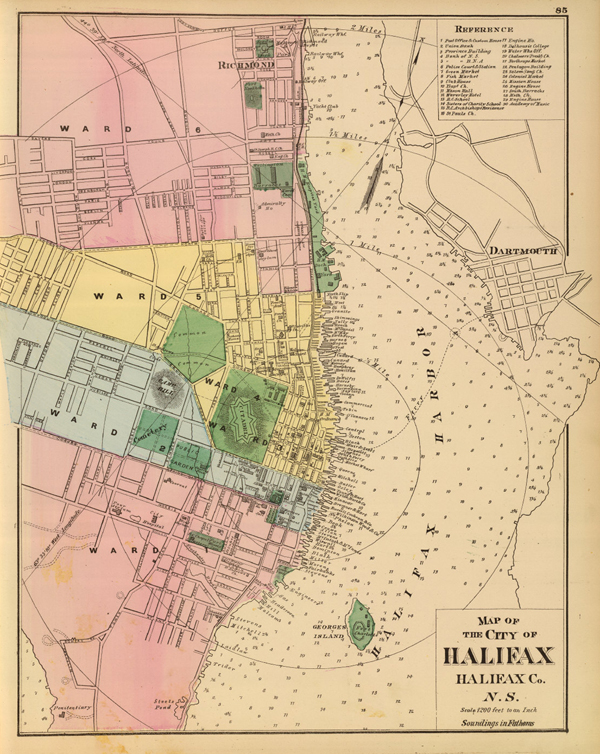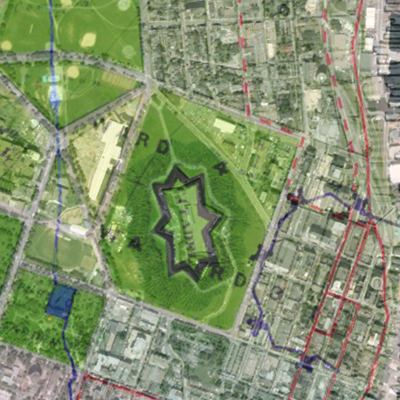![[Re]Presenting Halifax](http://farm3.static.flickr.com/2685/4310147878_08abb0d1b4_o.jpg)
![[Re]Presenting Halifax](http://spacing.ca/network/wp-content/uploads/sites/8/feature-representing-hfx-60.gif)
This is the first of a series of explorations through maps of the Halifax region.
Revisiting maps, diagrams and other interpretive readings of Halifax that have long been buried can only help to further the discussion and debate about the current direction and future vision for the region.
The overall objective is to re-present the city within the historical and contemporary socio-political, spatial, and ecological dimensions and challenges in a manner that helps to reveal opportunities and contribute to a wider discussion on current conflicts, debates and developments. The ‘agency’ or capacity of the map is explored in parallel to the region’s ability to adapt to and meet some of the increasingly diverse needs and demands of the city, its users, and inhabitants.
This proposal loosely imitates recent interpretive mapping exercises as published in Mapping Boston and Mapping London (among others), that demonstrate a renewed interest in both mapping/map as process and product. While this exercise is much more modest in scale, it is also well suited for collaboration and contributions for others interested in the topic – so, please, join in on this subjective cartographic journey through the past and potential of Halifax! Anyone interested in contributing to this interpretive reading of the city is encouraged to send an email with suggestions, ideas, or proposals.
I begin with a rather simple plan of the city centre and immediate surroundings produced in 1878, as it offers a glimpse of the city as both expanding port and fort town – a colonial town – yet, before its relationships to the landscape were eroded beyond recognition.
At this point in time, the Halifax Common lands are strong features and, although not much more than pastures, suggest a central sponge for the peninsula – the centre of a natural drainage and purification system. Freshwater Brook – today almost completely buried, canalized and diverted – flows north to south from the North Common and empties into the harbour near the bottom of Inglis Street (at a point that is prone to flooding today).
While much of the original path of Freshwater Brook has remained parkland – from the North Common, Public Gardens, and Victoria Park – the most recent plan for the North Common proposes the further hardening of paths, entrance and one baseball field (converting it into a small plaza). Presented in isolation from its surroundings and any remnants of natural systems, the plan for the North Common seems incredibly short-sited, as it simplifies a complex site in the heart of the city.
The second image (below) shows the extent of urbanization on the peninsula by 1917 (dark grey). Heavy rail infrastructure lines are visible along the water’s edge, with the main rail station located at the base of where the MacDonald Bridge approach sits today. Tramlines extended nearly the length of the peninsula, from the area now known as the Hydrostone to Point Pleasant Park (those shown here existed between 1878 – 1898). Other lines running west along Cunard Street and Spring Garden Road facilitated expansion away from the harbour, which had always been the main structuring element.
Three strong natural elements – sponge, river, shoreline – overlaid by high capacity, high frequency transit infrastructure hints to a strategy for sustainable development of the region, achieved through the integration of city and nature. Yet, this is not what we see today. Still, much of the potential held within this image of the city still exists – buried beneath layers of asphalt or hidden by incoherent planning and development decisions.
With the city trumpeting HRMbyDesign as a sustainable way forward for the region, and pushing to increase the number of people living on the peninsula, there seems to be too many (and too hollow) visions and far too few plans and strategies to make it happen. By shifting the emphasis from invented, intangible, and rigid notions of precincts or districts to stronger contextual qualities of the physical landscape, we may finally be able to take a first step towards a positive shared future.
Base map from the David Rumsey Collection; satellite image taken from Google Earth; maps modified by author.




5 comments
Matt,
This looks like an interesting project – Halifax’s history as a government town/naval station, and the site of a serious reconstruction post-Explosion means that there have been many interpretations of the city put to paper in the past. In my spare time, I’ve been digitizing StatCan data onto Google Earth projections of HRM, but this concept looks far more exciting!
-ms
“Tramlines extended nearly the length of the peninsula, from the area now known as the Hydrostone to Point Pleasant Park” …This is a very interesting piece of historical knowledge for anyone who doubts the economics of tramways in a city the size of Halifax.
Michael,
You are right – with its military history, there are plenty of maps to explore and I expect many posted here will be reflections on historical interpretations/plans. But by having few limits on the type of graphic representations we include, there is the potential to learn from even the most recent maps. A few days ago, I found a tourist map in a coffee shop downtown and although far from precise or accurate, it is interesting to think about how the city is perceived and expressed by the author of the map, and how this is then passed on to the targeted audience – in this case, tourists.
I was looking through your StatCan maps – very interesting. Could be nice to overlay past and present HRM strategic plans/land-use plans/infrastructure plans,etc to see how these relate – or see what development and change is/was planned (and its level of success at structuring growth) and what has just ‘ happened’. Maybe something to think about. Contributions are encouraged!
Matt
This was a great article — and well discussed in combo with the maps! My Masters’ Thesis in Architecture was on this very subject, so I’m glad too see this kind of piece. You’re very right: there is much to learn from the intersections of Nature and City — and quite often if we study maps through time, the city itself reveals where it wants to go in terms of development. This kind of information / study in concert with a vision for the city at the level of government and community would go a long way.
They should seriously bring the fresh water brook back to the surface, at least along the stretch of park just across the street from the front gates of Public Gardens on the opposite side of Spring Garden road, which would be kind of an extension of the gardens itself (maybe an under-the-street tunnel to take one from the gates of PG to the other side for tourists and those who fear getting hit by cars :-))) ?) But someone would probably just get mugged in there, so scratch that idea.